Churchill Weekly Polar Bear Stats


This exceptional post my Natural Habitat Adventures guide Brad Josephs is a story of perseverance and making the best of a situation out of one’s control. An experience can take on a life of its own if the effort is put in!
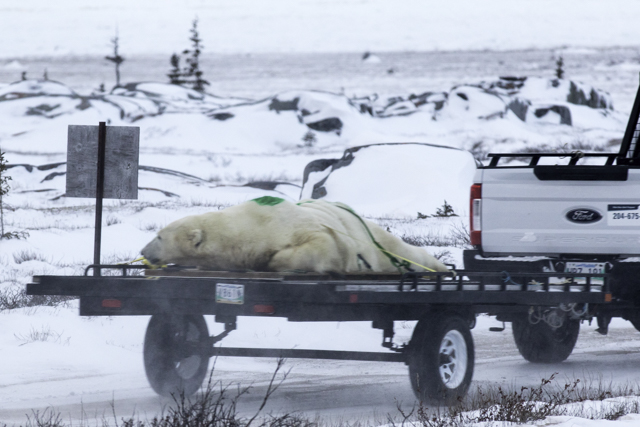
The first amazing experience happened a few hours after our arrival to Churchill. Fellow guide Theresa Whipple spotted a polar bear alert truck towing a trailer with a sedated giant male bear on the back heading east from the polar bear jail. She called me on the radio and we headed out there. Brad Josephs photo.
This last polar bear season proved to be quite challenging after the first week of November due to record-setting early cold weather which caused the sea-ice to form earlier than it has in decades. This was such a different situation from last year when the ice formed unusually late. This, of course, is great news for the polar bears, which need ice as a platform to hunt seals, but when the bears move offshore we cannot find them on our bear viewing trips. I and two other guides were scheduled with the last trips of the season, extending until the 26th of November. These new “family trips” would have been spectacular last year, but this year most of the bears had moved to more than 60 miles offshore, which is too far for us to even find with helicopters! We maintained a positive attitude and tried our best to teach the young kids in our groups as much as possible about Arctic ecology, and have as much fun as possible. Luckily these trips turned out to be fantastic, and we were privy to some outstanding and rarely seen bear action.
Since the early 1980s, the province of Manitoba has employed a force of bear patrol officers who haze polar bears away from town and incarcerate problem bears in the Polar Bear Holding Facility, aka the Polar Bear Jail. When the ice has formed on Hudson Bay, the officers release the bears on the beach outside of town. When the bears see the ice, they lose any interest in prowling around town and head offshore to hunt seals. In my 13 seasons guiding in Churchill, I have never witnessed these releases, though it has always been a dream of mine to see it.

We found several Polar Bear Alert Conservation Officers unloading two huge bears on the beach at the edge of the frozen sea. Brad Josephs photo.

The 1,000+ pound polar bear, immobilized with Telazol, was carefully rolled onto the beach. In 45 minutes he woke up and headed onto the ice. The green dot on his back lasts for around a week and shows anyone from a distance that the bear has recently been released. It also shows possible substance hunters from villages to the north that the bear has toxic drugs in his system from being immobilized, and shouldn’t be consumed. Brad Josephs photo.
The highlight of the entire trip for most of the group happened like magic. One of the officers came to our group in his truck and asked how many little kids we had. He knew with the bears having disappeared from town that we were going to have a rough time meeting the expectations of the kids. I couldn’t believe it when he told us to load the little ones in his truck so he could drive them up to the waking giant bear for a close look! What an amazing experience that these young guys would never forget. Brett, if you are out there, you are a hero in my book forever!
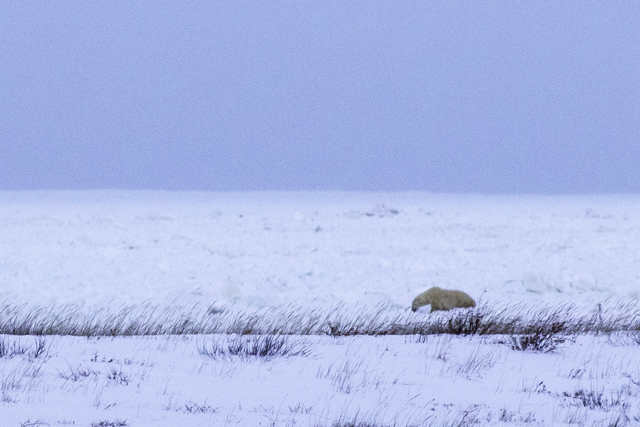
The bear is awake and moving around groggily after 45 minutes. He’s a FREE BEAR and theres ice to hunt on! Brad Josephs photo.
The next morning we all boarded helicopters to hopefully see bears on the ice. Since the ice edge was an estimated 60 miles offshore, we knew that we may not find any, as we cannot travel that far by helicopter. We were so happy to see many bears! To fly over that vast expanse of rugged ice and finally reach the bears who were hunting seals was for me, a lifetime wildlife viewing highlight. We even saw one of the bears that had been released the previous evening, already more than 10 miles offshore! The climax was seeing a bear eating a seal. WOW doesn’t describe it!
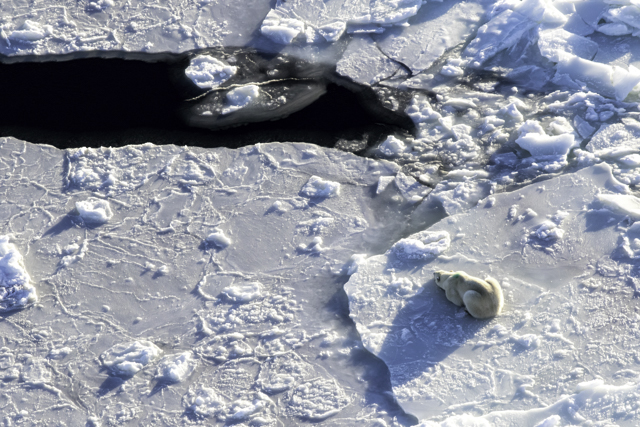
The green dot shows us this bear was released the evening before! The next morning we see him waiting next to a patch of open water, watching for seals! Brad Josephs photo.
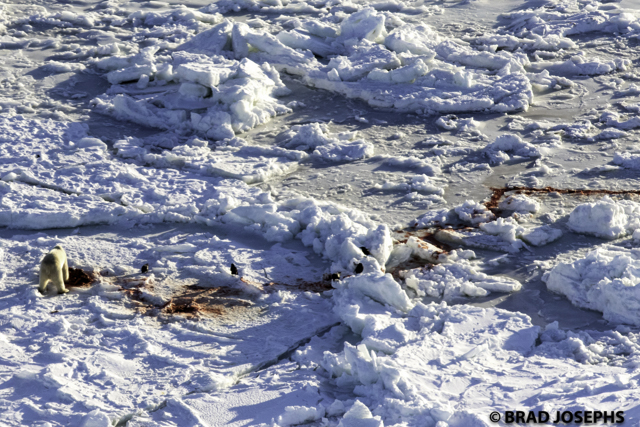
We found this young bear who had very recently caught a seal from a breathing hole, dragged it to more solid ice, and was happily devouring the blubber. Brad Josephs photo.
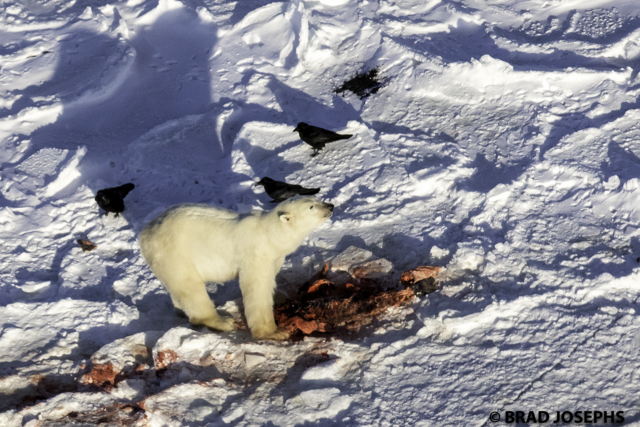
I was thrilled to see ravens with the bears. These tough birds, as well as arctic foxes, travel hundreds of miles onto the pack ice to scavenge seal kills. I wonder if the ravens help the bears find breathing holes—I bet they do. Brad Josephs photo.
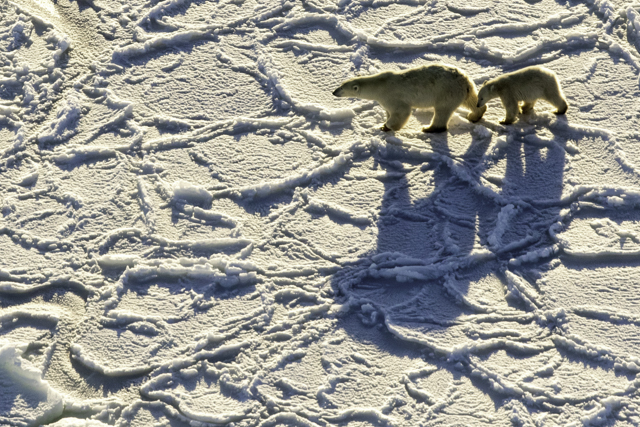
Mom and cub searching for seals on the ice. Brad Josephs photo.
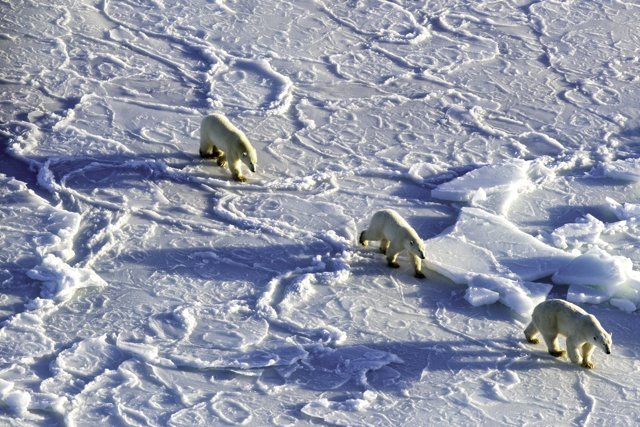
Mom and two 2-year-old cubs. Brad Josephs photo.
When our helicopter trip was finished the pilot said the conservation officers needed helicopter assistance with a problem bear in town. We loaded the bus and sat at a high point in town and waited for the action, and found it though it was a little too close for comfort, but very exciting for the kids.
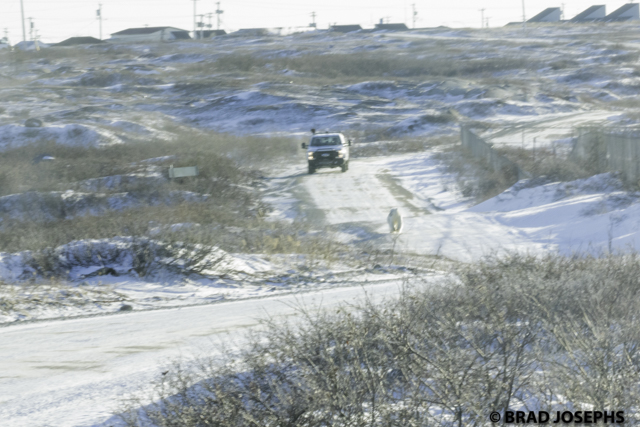
Polar bear alert chases a cub out of town. The bear raced down the road towards us. We had to move the bus to get out of the way. Some of my folks said it was like being in the middle of a James Bond movie, as the helicopter hovered over us, and the bear was darted by an officer hanging from an open window. Brad Josephs photo.

Officers immobilized the orphaned 1-year-old cub from the helicopter with a dart. The cub’s chance of survival in the wild is south of zero at that age, so he will be transferred to the polar bear exhibit at the Winnipeg Zoo most likely. Brad Josephs photo.

Jack Batskill is a legendary Polar Bear Alert officer. Through his many years of dealing with polar bears, he is revered as a leading expert in his field, and respected by all in the bear world. Brad Josephs photo.
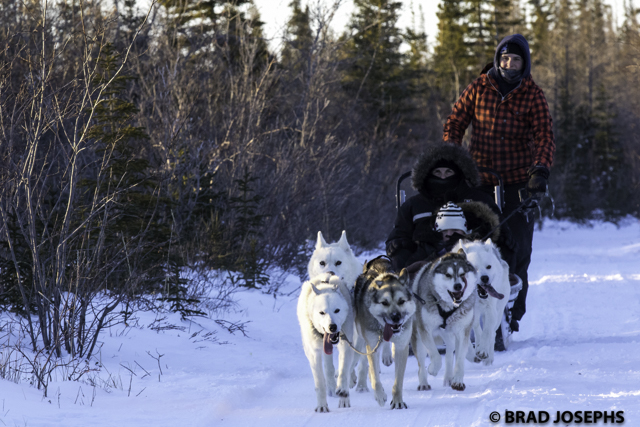
Dog sledding in the boreal forest. Brad Josephs photo.

I found a snowshoe hare in the boreal forest for the kids to see. Brad Josephs photo.
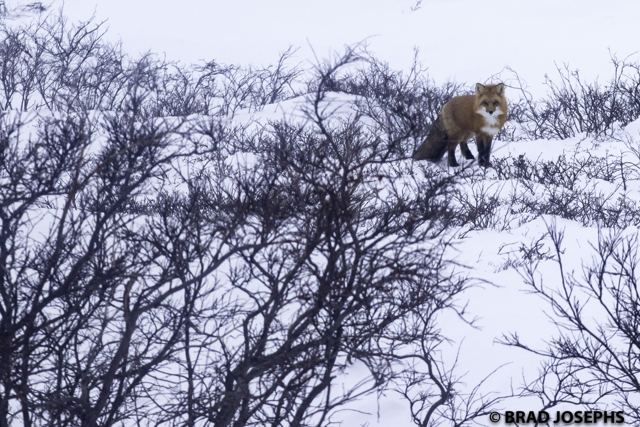
On the last day we explored the tundra in a Polar Rover. We didn’t see any bears, but after the action of the previous days it was OK. The kids understood, and we had a blast looking for foxes and other wildlife. This is a red fox. Brad Josephs photo.
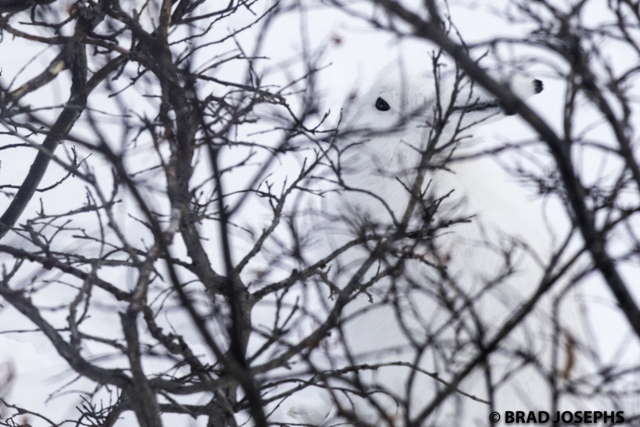
12-year-old Eleanor Fraser won my “animal spotter award” for seeing this nearly invisible arctic hare in a willow patch. Way to go, Eleanor! Brad Josephs photo.
What an awesome trip! I am so glad it was so thrilling for the kids, as getting the young generation interested in our natural world is the only way to ensure conservation in the future.
Check out Natural Habitat’s new family trips if you want to take your kids on an educational adventure that is parent and kid friendly. Let us plant seeds of appreciation for the natural world in the young ones and encourage a new generation of conservationists!
Keep exploring! Brad
Churchill is famous for its polar bears and has been dubbed the Polar Bear Capital of the World for a destination to see numerous polar bears in and around the town.
Now Churchill Mayor Mike Spence wants to have serious conversations with the provincial government about finding alternatives to shipping the animals to Winnipeg and other destinations where they ultimately end up spending the rest of their lives in zoos.

Churchill Mayor Mike Spence wants polar bears to have alternatives other than being sent south to Winnipeg.CBC photo.
Churchill Mayor Mike Spence and other Churchillians are concerned the old habit of just relocating orphaned cubs is outdated and archaic. The most recent capture of a pair of orphaned polar bear cubs from different mothers by provincial conservation officers has them talking and advocating for a different fate for the animals.
“It has always been an issue here,” says Spence.
“Polar bears are a critical part of the community. But once you have taken them out of the population, that’s it. They’re gone. I’ve told the minister we want to sit down and talk.

Polar bear cubs approach the polar rover within a few feet. Jeff Klofft photo.
“We want to get more research on polar bears. We need to do things differently. We can’t just continue to do nothing other than shipping them off to zoos.”
According to Spence, ideas for changing the current protocol include tracking devices to monitor the bears’ travel and a facility designed to allow the bears to be reintroduced into the harsh northern environment.
“We need to do something more than just saying, ‘Another bear gone to the zoo,’” he said. “We don’t accept sending cubs to captivity is the answer.”
The latest capture, like nearly all the polar bears relocated in recent years, will end up at Assiniboine Park Zoo’s Leatherdale International Polar Bear Conservation Centre.
Statistics, as vague as they might be, tend to point to unfavorable survival rates when young abandoned cubs are left in the wild. Sustainable Development Minister Rochelle Squires states that scientists know there is little hope for those animals.
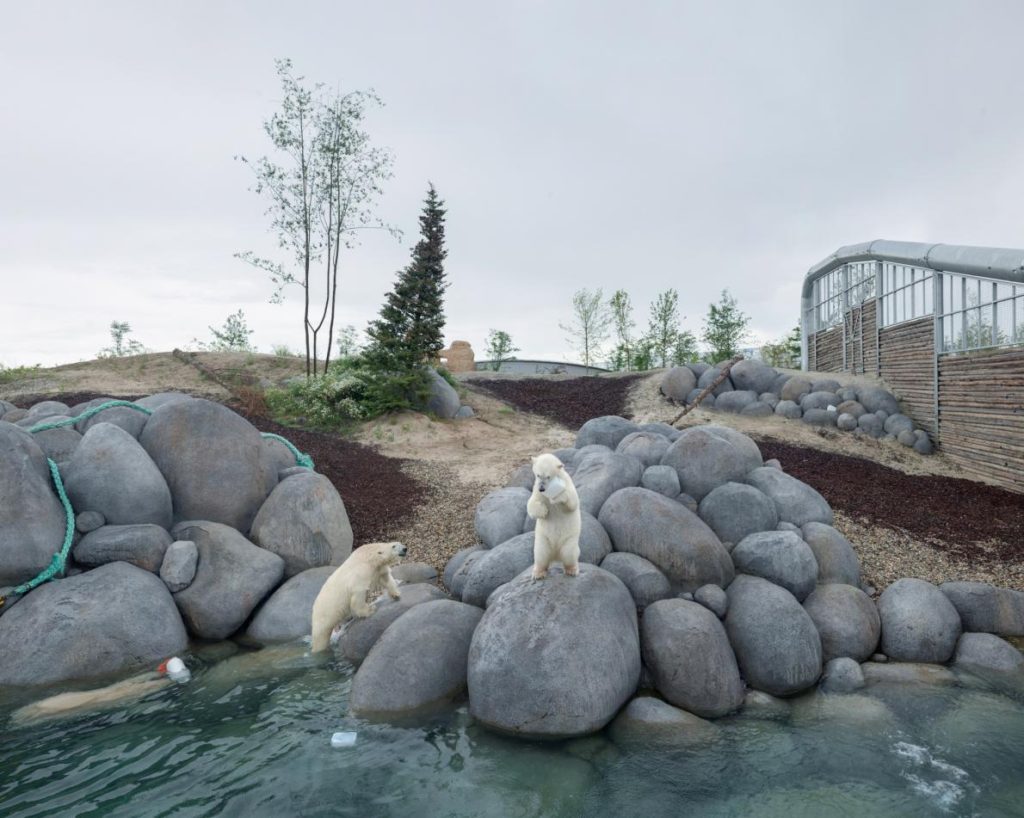
Polar bears living out their lifespan in the Netherlands Wildlands Zoo. Sheng – Wen Lo photo.
“The unfortunate reality is that young cubs have very little chance of survival without their mother,” Squires said.
“Without a female to protect them, cubs are highly vulnerable to natural predators and also to the significant risk of starvation. Polar bear cubs depend on their mothers until they are about 2 1/2 years of age, by which time they’ve grown and learned to hunt for their own food.”
“Polar bears truly are irreplaceable and we consider them a jewel for the community of Churchill. For that reason, we will continue to devote resources to managing polar bears in the area and producing new research that supports their sustainability. While the Department of Sustainable Development is keenly focused on ensuring their survival, our government is committed to working collaboratively with the community to determine the future of these orphaned polar bears cubs.”
Let’s hope these new ideas come to fruition in the near future. Polar bears should be in the wild not automatically sent to zoos without exploring other options.
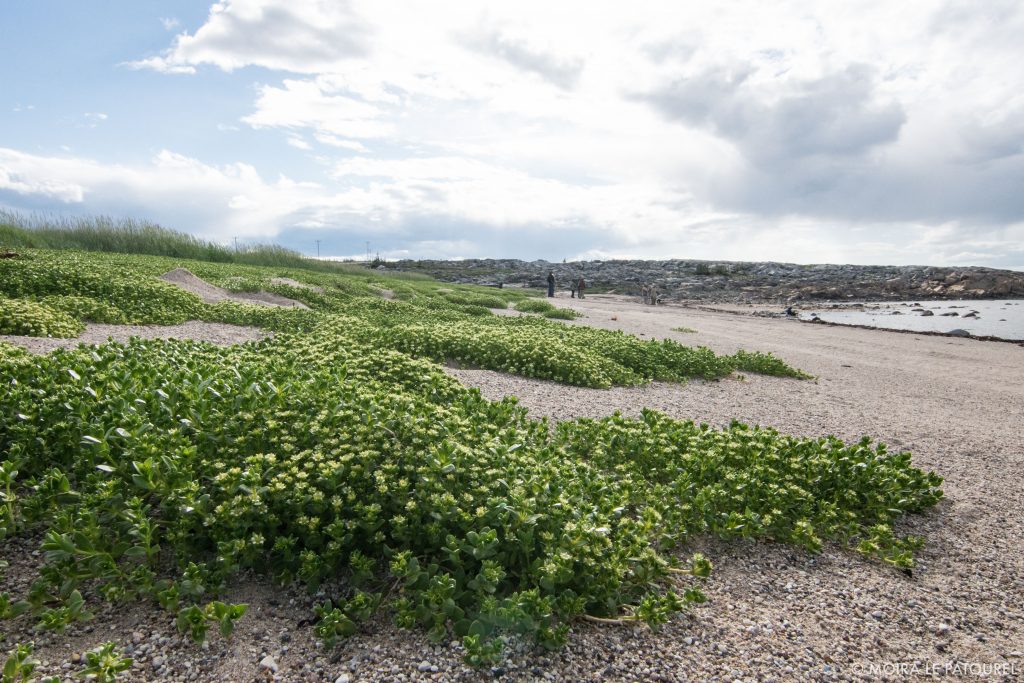
Sea pursalane inhabits the beach areas in Churchill. Moira Le Patourel photo.
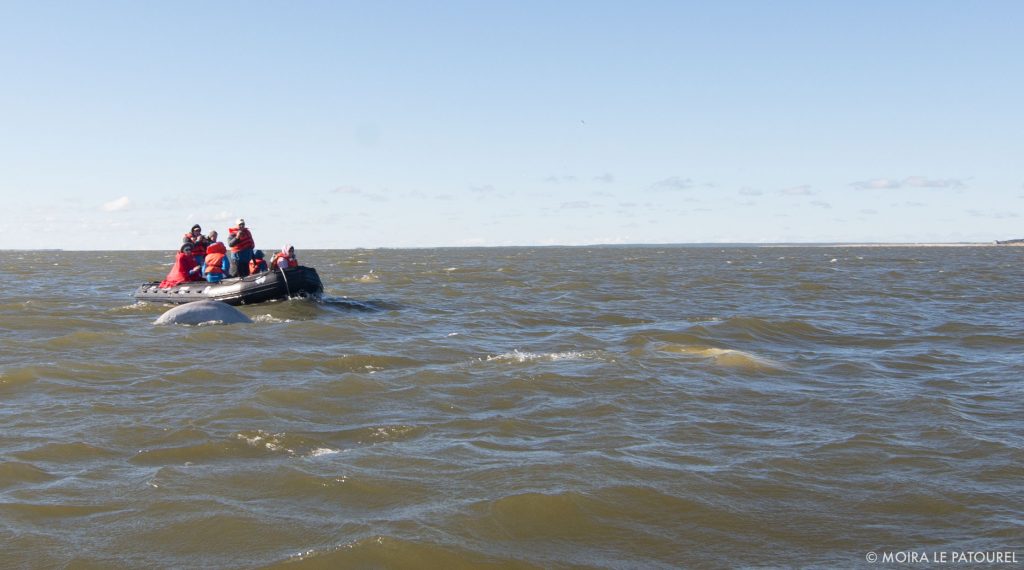
Beluga whales in the Churchill River with excited Nat Hab travelers. Moira Le Patourel photo.
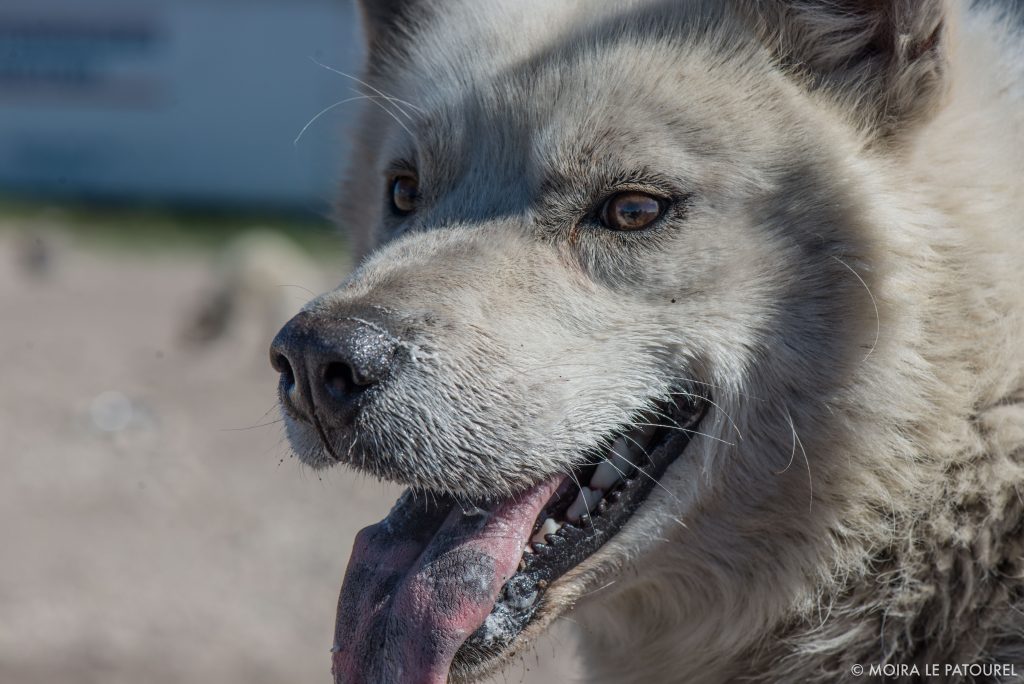
Churchill sled dogs are alaways a popular attraction. Moira Le Patourel photo.

Polar bears in the snow in the Churchill Wildlife Management Area. Katie de Meulles photo.
We wish everyone a very happy Valentines day from Churchillpolarbears.org! Enjoy the day with the special bears ..er people in your lives!
